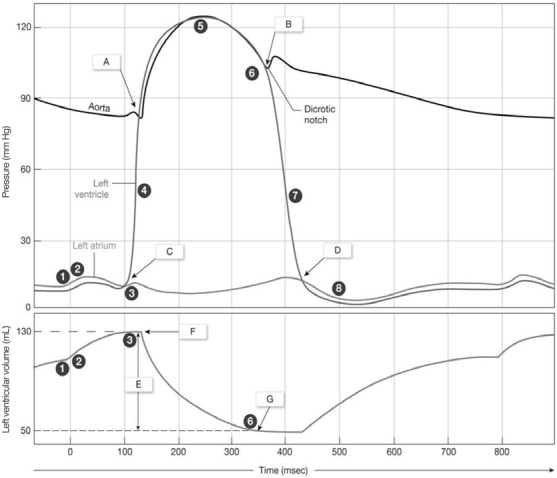A) tachycardia.
B) bradycardia.
C) hypercardia.
D) hypocardia.
E) procardia.
G) B) and D)
Correct Answer

verified
Correct Answer
verified
Multiple Choice
The ________ is shared by the two ventricles.
A) vena cava
B) bicuspid valve
C) chordae tendineae
D) interventricular septum
E) trabeculae carneae
G) All of the above
Correct Answer

verified
Correct Answer
verified
Multiple Choice
Which of the following describes what is directly measured by an ECG?
A) the force of contractions
B) blood vessel resistance
C) end-systolic volume
D) electrical conduction
E) neural stimulation of cardiac myocytes
G) B) and D)
Correct Answer

verified
Correct Answer
verified
Multiple Choice
The ________ carry blood away from the heart.
A) arterioles
B) arteries
C) veins
D) venules
E) capillaries
G) None of the above
Correct Answer

verified
Correct Answer
verified
Multiple Choice
In an adult at rest, the end-diastolic volume is typically
A) 50 mL.
B) 80 mL.
C) 130 mL.
D) 320 mL.
E) 560 mL.
G) None of the above
Correct Answer

verified
Correct Answer
verified
Multiple Choice
An ECG is used to diagnose all of the following conditions except
A) an AV block.
B) an ectopic pacemaker.
C) angina pectoris.
D) premature atrial contractions.
E) ventricular tachycardia.
G) B) and E)
Correct Answer

verified
Correct Answer
verified
Multiple Choice
Pacemaker cells isolated from the SA node generate action potentials at ________ beats per minute.
A) 20-40
B) 40-60
C) 80-100
D) 100-140
E) 140-180
G) A) and D)
Correct Answer

verified
Correct Answer
verified
Multiple Choice
A tumor on the adrenal gland increasing catecholamine release will cause all of the following cardiovascular responses except
A) decreased heart rate.
B) increased contractility.
C) increased venous return.
D) increased preload.
E) decreased ESV.
G) B) and C)
Correct Answer

verified
Correct Answer
verified
Multiple Choice
Figure 20-2 Cardiac Cycle
 Use Figure 20-2 to answer the following questions:
-What occurs at the area labeled "C" on the graph?
Use Figure 20-2 to answer the following questions:
-What occurs at the area labeled "C" on the graph?
A) AV valve opens.
B) AV valve closes.
C) Ventricular filling begins.
D) Semilunar valve closes.
E) Semilunar valve opens.
G) C) and E)
Correct Answer

verified
Correct Answer
verified
Multiple Choice
Heart rate is controlled by neurons of the cardiovascular center located in the
A) pons.
B) thalamus.
C) medulla oblongata.
D) hypothalamus.
E) higher centers.
G) C) and E)
Correct Answer

verified
Correct Answer
verified
Multiple Choice
Figure 20-2 Cardiac Cycle
 Use Figure 20-2 to answer the following questions:
-What volume is labeled "E" on the graph?
Use Figure 20-2 to answer the following questions:
-What volume is labeled "E" on the graph?
A) cardiac output
B) stroke volume
C) end-diastolic volume
D) end-systolic volume
E) total cardiac volume
G) A) and C)
Correct Answer

verified
Correct Answer
verified
Multiple Choice
Thick projections of muscle in the ventricles that anchor chordae tendineae are called
A) pectinate muscles.
B) conus arteriosus.
C) papillary muscles.
D) trabeculae carneae.
E) auricles.
G) C) and D)
Correct Answer

verified
Correct Answer
verified
Multiple Choice
If the pacemaker cells in the SA node become more permeable to potassium ions, the
A) heart rate will increase.
B) heart rate will decrease.
C) cells will depolarize.
D) cells will hyperpolarize.
E) heart rate will decrease and cells will hyperpolarize.
G) B) and C)
Correct Answer

verified
Correct Answer
verified
Multiple Choice
These structures keep the aortic valve cusps from sticking to the wall of the aorta.
A) auricles
B) chordae tendineae
C) papillary muscles
D) pectinate muscles
E) aortic sinuses
G) A) and C)
Correct Answer

verified
Correct Answer
verified
Multiple Choice
The heart lies within the ________ cavity.
A) peritoneal
B) pleural
C) orbital
D) dorsal
E) pericardial
G) A) and B)
Correct Answer

verified
Correct Answer
verified
Multiple Choice
The marginal branch and posterior interventricular branch are branches of the
A) right coronary artery.
B) left coronary artery.
C) circumflex artery.
D) coronary sinus.
E) aorta.
G) A) and B)
Correct Answer

verified
Correct Answer
verified
Multiple Choice
Cardiac muscle layers form this distinct pattern.
A) inner longitudinal layer
B) outer longitudinal layer
C) outer circular layer
D) figure eight
E) weave
G) A) and E)
Correct Answer

verified
Correct Answer
verified
Multiple Choice
The atrioventricular valves permit blood flow
A) in one direction only.
B) in both directions.
C) in many directions.
D) in opposite directions on the right and left.
E) from a ventricle to an atrium.
G) A) and E)
Correct Answer

verified
Correct Answer
verified
Multiple Choice
The ________ covers the outer surface of the heart.
A) epicardium
B) myocardium
C) endocardium
D) parietal pericardium
E) mediastinum
G) B) and D)
Correct Answer

verified
Correct Answer
verified
Multiple Choice
Drugs that block the beta-one adrenergic receptors will
A) increase heart rate.
B) decrease heart rate.
C) increase contractility.
D) increase cardiac output.
E) decrease the end-systolic volume.
G) C) and D)
Correct Answer

verified
Correct Answer
verified
Showing 61 - 80 of 178
Related Exams